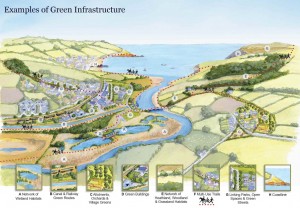‘Green infrastructure’ is a term used to describe the network of natural spaces and corridors in a given area.
Green infrastructure assets include open spaces such as parks and gardens, allotments, woodlands, fields, hedges, lakes, ponds, playing fields, coastal habitats, as well as footpaths, cycleways or rivers. Assets involving water can also be called ‘blue infrastructure’, but these are all included in the overarching term of ‘green infrastructure’.
These assets provide areas for recreation and education, habitats for wildlife and also provide environmental services such as flood defence or absorption of air pollution. If they did not exist, then our lives would be very different. For this reason, these natural and semi-natural areas are identified as part of the basic ‘infrastructure’ that enables us to live as we do.
The diagram below (which you can click on to enlarge) shows examples of green infrastructure.
What is the green infrastructure ‘approach’?
The green infrastructure approach advocates that green infrastructure assets should be protected and enhanced to help sustain and improve our way of life. Green infrastructure assets should be linked to form part of a wider network, as this helps them to withstand climate change and other impacts.
Providing new green infrastructure assets can be an alternative to providing engineered structures using concrete and other hard materials otherwise known as ‘grey infrastructure’. Green infrastructure however tends to be multi-functional, often providing the added benefit of providing for biodiversity as well as, for example, flood relief or a cycle route.
Delivery of the green infrastructure approach requires planning for the future.
Why is any of this important?
Green infrastructure assets provide for ecosystem services, see the box below for more information. Clearly without these services, life as we know it could not exist.
Protection and management of our environment is vital to our survival. Recent human activity has resulted in pollution of land, water and air, loss of biodiversity, and degradation of our landscapes at a scale and at a rate never experienced before. This significantly limits the ability of the environment to provide these services.
The green infrastructure approach advocates recognising and strengthening the ability of green infrastructure assets to deliver ecosystem services.
As well as the benefits that green infrastructure provides to society, it is also important to recognise that humans exist within a wider ecosystem, the conservation of which is vital. The green infrastructure approach can significantly aid this conservation.
What are ecosystem services?
The natural environment provides services for people and society, by providing:
- supporting services: including photosynthesis, soil formation, as well as nutrient and water cycling. These functions are fundamental to sustaining life
- provisioning services: products obtained from ecosystems, including food, fibre, fuel, genetic resources, natural medicines, pharmaceuticals and fresh water support our economy and culture
- regulation of our environment: through natural processes, the environment provides air quality regulation, climate regulation, water regulation, erosion regulation, water purification, disease regulation, pest regulation and pollination, all free of charge
- cultural benefits: the non-material benefits people obtain from ecosystems through spiritual enrichment, education, cognitive development, reflection, recreation and aesthetic experiences improve our quality of life and help to make it enjoyable
